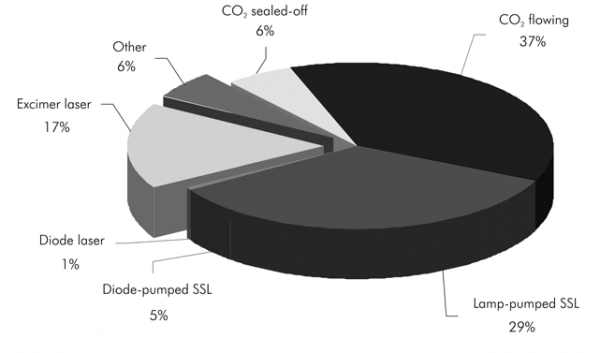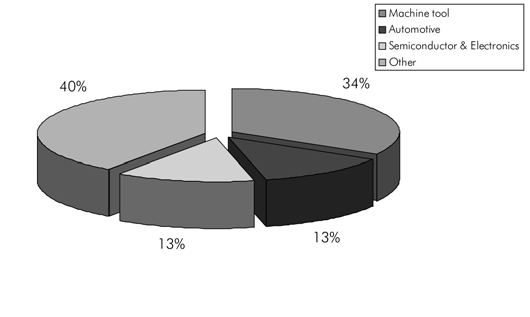A breakdown of laser market
Today, lasers are used for machining purposes throughout almost all sectors of industry. Typical markets include the automotive industry and mechanical engineering as well as the semiconductor and electronics industries.

An international comparison reveals marked differences regarding the quantitative demand for lasers in individual market segments. This is partially due to traditional factors and the relative size of the industrial sectors in the economic areas surveyed.
In the USA, it is the automotive industry and the metal-working industry that are the leading sectors for laser beam sources. In Asia, on the other hand, the electronics and semiconductor industries are primary customers for laser suppliers. The European market is characterized by high sales figures for the metal-working and automotive industries, as opposed to a comparatively minor share achieved by the electronics and semiconductor industries. According to an international survey, Europe also stands out by the popularity of lasers in other sectors of industry, such as plastics processing.
Not all laser applications that have passed the experimental stage in research laboratories can be used on an industrial scale. This is due to a variety of factors. The first requirement for the implementation of a newly developed laser application in actual production is the industrial availability of suitable beam sources and system components at the time of intended use. If there are alternative, equally viable manufacturing techniques for the product in question, then all technological and economical arguments must be carefully considered and weighed. An important criterion pertains to the question of whether the laser method, apart from meeting the pertinent quality standards, is really economically superior to conventional methods. Primary economical factors include the process speeds, investment and operating costs, and the fixed and variable costs, respectively. Laser applications have better prospects if they are newly introduced to the production process, if a required innovation of a given product and/or production process is the exclusive domain of the laser and cannot be realized otherwise. Today there are many applicational examples that demonstrate the technical and economic superiority of the laser technique over conventional processing methods.
Market shares of laser types
Industrial materials processing today relies primarily on CO2 lasers, Nd:YAG lasers, and excimer lasers. To an increasing extent, however, diode lasers are also gaining access to this market segment, either as pump sources for solid-state lasers (SSL), or used directly for a variety of different areas of application.

CO2 lasers were launched in the industrial market more than two decades ago and are now available in a wide range of different design types, with a beam power of up to 20 kW and more. Nd:YAG lasers, which are also available in the multi-kW power range, have also conquered a considerable market share. Nd:YAG lasers have a wavelength that allows a more flexible beam guiding system by optical fibers as well as superior focusing ability compared to CO2 lasers. Another advantage is their higher absorption in conjunction with metals. Due to these benefits, Nd:YAG lasers have opened up new manufacturing areas that used to be outside the scope of lasers.
Excimer lasers, too, have become indispensable for a number of industrial applications, and research institutions are now working on the basic concepts for additional industrial applications.
Percentage contribution of individual processing methods
Based on their respective operating principles and partially also for traditional reasons, primary applications for CO2 lasers and Nd:YAG lasers include different processing techniques.
CO2 lasers are used primarily to cut plane metal sheets. In the future, however, considerable growth rates are expected for welding applications too, since inexpensive high-power beam sources are broader in scope regarding the welding depths and processing speeds to be realized.
The most common applications for Nd:YAG lasers include marking and micro-structuring, welding and cutting of micromechanical and electronics elements as well as spot welding of fine structures. Today, high-power Nd:YAG lasers in the multikilowatt power range are primarily used for welding purposes. The introduction of diode-pumped lasers opened up new areas of application, for instance in the cutting of hydroformed parts.
User sectors and application potential
Often, it is only in the presence of strong competition within their sector of industry that companies start looking to product and production innovations to reduce costs.
The need for excellent production quality, high productivity, and superior flexibility, combined with the requirements of large-scale manufacturing as well as the demand for automation often justify the comparatively costly investment in laser technology for material processing.
This situation is encountered mainly in the automotive, semiconductor and electronics industries, where large numbers of components are marked, cut and welded by lasers. Once industrial laser applications can be standardized on machines with a modular construction, machine tool manufacturers will be able to exploit the laser’s flexibility in terms of volume, geometry and processing to achieve cost-effective
laser processing of materials, even for smaller batch sizes in small and mediumsized companies.

